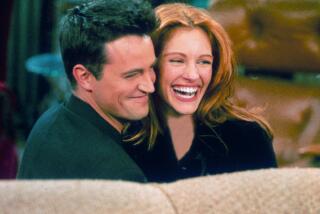FANS : Magnificent Obsession
- Share via
Not long ago, an up-and-coming actor met a producer at a Beverly Hills hotel and managed to nab a good part. The pro ducer was impressed by the cult following the young actor seemed to have--he’d been accosted in the hotel lobby by fans who squealed, pointed and jumped up and down at the sight of him. But these were no ordinary fans. They were professionals in the employ of the Rent-a-Fan Club, and their brief skit had cost the actor $125--a very reasonable investment, as it turned out.
Movie fans--the authentic variety--originated about the same time as movie stars, in 1910. That was the year that Carl Laemmle, head of IMP studios, revealed the name of “Biograph Girl” Florence Lawrence, who had been reported killed in a streetcar accident. (Until then, movie actresses, by-and-large, had remained anonymous, receiving no more recognition for their contributions to the film industry than anyone else--and often a good deal less. Mary Pickford, for instance, was called “the girl with the golden hair” before she was allowed to have a name.) IMP, having recently hired Lawrence, took out advertisements stating that the Biograph Girl was alive and well and, in fact, working for IMP, and lest there be any doubt, the studio disclosed her identity. Lawrence’s name was added to the credits of the movie she was working on, and thus was born the first movie star. Within a year, her name was not only above the title; it was bigger than the title.
Movie fans tend to be more zealous than sports or music fans, perhaps because their demigods are larger than life. A Mrs. Myra Franklin of Cardiff, Wales, has seen “The Sound of Music” 940 times, a degree of dedication that can’t be explained by pure enjoyment. During World War II, the federal government asked Veronica Lake, “The Girl With the Peek-a-Boo Bangs,” to trim her flowing blond locks because too many young women in munitions factories were suffering accidents when their peek-a-boo hair became entangled in the machines. Fanatical fan loyalty itself has been the subject of movies (“The King of Comedy,” “The Fan”) and novels (Irving Wallace’s “The Fan Club”). A few real-life examples:
Secret Sharers. “Doll sharing” is an annual rite of the Shirley Temple Collector’s Club. Every year on her birthday, Temple worshipers show each other 13-inch and 18-inch Shirley Temple dolls, with a rare 27-incher making an occasional appearance. Collectors also share doll carriages, slippers, hair ribbons, and paper-doll and coloring books. Yet they never invite the birthday girl, now Shirley Temple Black, herself. As one fan reasoned: “The nicest thing we can do is leave her alone. She has a right to be spared people forever saying, ‘You were so cute as a child.’ ”
Trekkies. Although NBC tried to cancel the show twice, outspoken fans of “Star Trek” organized a letter-writing campaign that saved the TV series for another season. Trekkies also initiated a successful letter-writing campaign to christen the first space shuttle the Enterprise; 40,000 letters poured into Washington and the main cast of “Star Trek” showed up at NASA’s unveiling ceremonies. The fans’ devotion did not go unnoticed by Paramount Pictures. The result: “Star Trek: the Motion Picture.”
Il Capo. Benito Mussolini was a big Laurel and Hardy fan. In 1938, he sent his son Vittorio to Hollywood to persuade them to come to Rome to star in a production of “Rigoletto.” Deteriorating relations between America and Italy nixed the plan.
What They Really Talked About at Yalta. “That Hamilton Woman” (1941), starring Laurence Olivier as Lord Nelson and Vivien Leigh as Lady Hamilton, was the favorite movie of both British Prime Minister Winston Churchill and Soviet Premier Josef Stalin. Churchill saw it four times.
Why He Couldn’t Go Home Again. In 1935, when novelist Thomas Wolfe met literary agent H. N. (Swanie) Swanson in Hollywood to talk about a screenwriting career, Wolfe said he’d sign on one condition. “OK, Tom, you name it,” said Swanson, a fellow North Carolinian. “You gotta get me a date with Jean Harlow.” Wolfe was taken to the MGM lot and introduced to Harlow, who’d never heard of him but nonetheless gave him a ride in her limousine.
Touche: Just because they need each other doesn’t mean that fans and stars don’t fight. In 1933, Una Merkel, known for her supporting roles in films such as “42nd Street,” got a letter requesting a signed photograph. The fan then wrote to say, “Do not send picture. Am moving and decided I don’t want it.” Merkel shot back: “Picture is sent. You’ll take it and like it.” Barbra Streisand politely refuses requests to take her picture, explaining that “a little bit of me dies every time.” When she offered this apology to the proud mother of a rabbi Streisand was studying with, the woman replied, “Nonsense! You would have been dead a long time ago,” and snapped the photo.
More to Read
Only good movies
Get the Indie Focus newsletter, Mark Olsen's weekly guide to the world of cinema.
You may occasionally receive promotional content from the Los Angeles Times.








